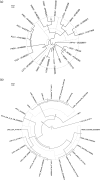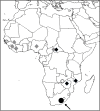Genomic and phylogenetic characterization of Merino Walk virus, a novel arenavirus isolated in South Africa
- PMID: 20071489
- PMCID: PMC2888150
- DOI: 10.1099/vir.0.017798-0
Genomic and phylogenetic characterization of Merino Walk virus, a novel arenavirus isolated in South Africa
Abstract
Merino Walk virus (MWV), a proposed novel tentative species of the family Arenaviridae, was isolated from a rodent, Myotomys unisulcatus, collected at Merino Walk, Eastern Cape, South Africa, in 1985. Full-length genomic sequence confirmed MWV as an arenavirus related distantly to Mobala, Mopeia and Ippy viruses, all members of the Old World arenavirus complex. We propose MWV as a tentative novel species in the Lassa-lymphocytic choriomeningitis virus complex, based on its isolation from a novel rodent species and its genetic and serological characteristics.
Figures





Similar articles
-
Genetic identification of Kodoko virus, a novel arenavirus of the African pigmy mouse (Mus Nannomys minutoides) in West Africa.Virology. 2007 Jul 20;364(1):178-83. doi: 10.1016/j.virol.2007.02.008. Epub 2007 Mar 23. Virology. 2007. PMID: 17382366
-
Gairo virus, a novel arenavirus of the widespread Mastomys natalensis: Genetically divergent, but ecologically similar to Lassa and Morogoro viruses.Virology. 2015 Feb;476:249-256. doi: 10.1016/j.virol.2014.12.011. Epub 2015 Jan 2. Virology. 2015. PMID: 25559385
-
Molecular characterization of a new highly divergent Mobala related arenavirus isolated from Praomys sp. rodents.Sci Rep. 2021 May 13;11(1):10188. doi: 10.1038/s41598-021-88046-5. Sci Rep. 2021. PMID: 33986310 Free PMC article.
-
Phylogeny and evolution of old world arenaviruses.Virology. 2006 Jul 5;350(2):251-7. doi: 10.1016/j.virol.2006.01.026. Epub 2006 Feb 21. Virology. 2006. PMID: 16494913 Review.
-
Arenavirus Quasispecies and Their Biological Implications.Curr Top Microbiol Immunol. 2016;392:231-76. doi: 10.1007/82_2015_468. Curr Top Microbiol Immunol. 2016. PMID: 26472215 Free PMC article. Review.
Cited by
-
The search for animal models for Lassa fever vaccine development.Expert Rev Vaccines. 2013 Jan;12(1):71-86. doi: 10.1586/erv.12.139. Expert Rev Vaccines. 2013. PMID: 23256740 Free PMC article. Review.
-
Novel arenavirus sequences in Hylomyscus sp. and Mus (Nannomys) setulosus from Côte d'Ivoire: implications for evolution of arenaviruses in Africa.PLoS One. 2011;6(6):e20893. doi: 10.1371/journal.pone.0020893. Epub 2011 Jun 9. PLoS One. 2011. PMID: 21695269 Free PMC article.
-
Lymphocytic choriomeningitis virus (LCMV) infection of macaques: a model for Lassa fever.Antiviral Res. 2011 Nov;92(2):125-38. doi: 10.1016/j.antiviral.2011.07.015. Epub 2011 Jul 27. Antiviral Res. 2011. PMID: 21820469 Free PMC article. Review.
-
Arenavirus budding: a common pathway with mechanistic differences.Viruses. 2013 Jan 31;5(2):528-49. doi: 10.3390/v5020528. Viruses. 2013. PMID: 23435234 Free PMC article. Review.
-
Serological assays based on recombinant viral proteins for the diagnosis of arenavirus hemorrhagic fevers.Viruses. 2012 Oct 12;4(10):2097-114. doi: 10.3390/v4102097. Viruses. 2012. PMID: 23202455 Free PMC article. Review.
References
-
- Auperin, D. D., Sasso, D. R. & McCormick, J. B. (1986). Nucleotide sequence of the glycoprotein gene and intergenic region of the Lassa virus S genome RNA. Virology 154, 155–167. - PubMed
-
- Beaty, B., Calisher, C. & Shope, R. (1995). Arboviruses. In Diagnostic Procedures for Viral, Rickettsial and Chlamydial Infections, 7th edn, pp. 189–212. Edited by E. H. Lennette, D. A. Lennette & E. T. Lennette. Washington, DC: American Public Health Association.
-
- Bendtsen, J. D., Nielsen, H., von Heijne, G. & Brunak, S. (2004). Improved prediction of signal peptides: SignalP 3.0. J Mol Biol 340, 783–795. - PubMed
Publication types
MeSH terms
Substances
Associated data
- Actions
- Actions
Grants and funding
LinkOut - more resources
Full Text Sources
Molecular Biology Databases

